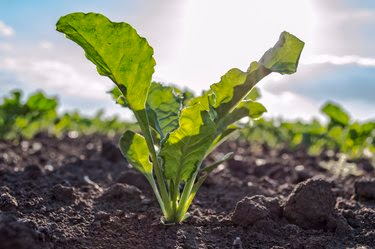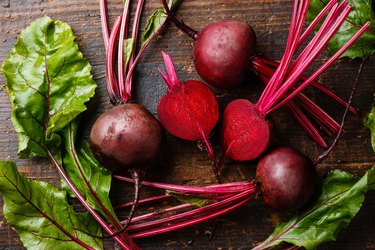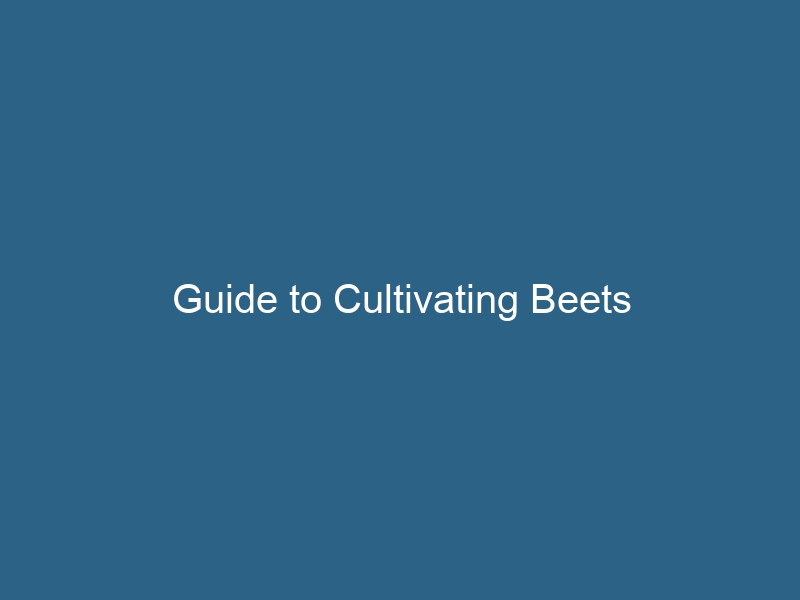Quck answer
Beets can be grown easily in your garden. Here are some steps to grow beets:
1. Choose a sunny spot in your garden with well-drained soil.
2. Prepare the soil by removing any weeds and loosening it with a garden fork.
3. Sow the beet seeds directly into the soil, about 1 inch deep and 2-3 inches apart.
4. Water the seeds regularly to keep the soil moist, but not waterlogged.
5. Thin out the seedlings when they are about 2 inches tall, leaving about 4-6 inches between each plant.
6. Mulch around the plants to help retain moisture and suppress weeds.
7. Harvest the beets when they reach the desired size, usually around 8-10 weeks after sowing.
By following these simple steps, you can successfully grow your own delicious beets in your garden.
If you decide to grow beets (Beta vulgaris) in your vegetable garden, you will be nurturing a versatile and nutritious plant. Depending on the variety of beet plant you choose, you can consume the leaves, the roots, or both. Beets are divided into four categories, which consist of two main groups: those that are grown for their roots and those that are grown for their leaves.
As a root vegetable, the common red beetroot, which also comes in different colors, has edible leaves known as beet greens or beet tops. Sugar beets are white and although all parts are edible, they are cultivated primarily for their high concentration of sucrose in their roots, which makes them a significant source of sugar.
There are also beets that do not develop a swollen tuberous root; these are grown exclusively for their leaves. Swiss chard is an example of a beet that does not produce a swollen root. It is cultivated solely for its leaves.
Although the beet plant is classified as an herbaceous biennial in botanical terms, it is grown as an annual crop with harvestable leaves and/or roots that mature in a single growing season. Regardless of the type of beet you choose to grow, you will follow the same basic cultivation guidelines.
Primary Uses for Beets
With the numerous uses for beetroots and beet greens, you can choose to enjoy them fresh, steamed, sautéed, baked, broiled, microwaved, and even pickled. Whether you have been a beet enthusiast for a long time or you are willing to incorporate this healthy vegetable into your diet, you can also blend beets into your favorite smoothie – either the roots or the shoots – to give it a nutritional boost. The high nitrate content in beets may even help lower your blood pressure.
How to Cultivate Beets
- Common Name: Beet, Swiss chard
- Botanical Name: Beta vulgaris
- Best Time to Plant: Spring and fall
- USDA Zones: 2-11 (as an annual)
- Sun Exposure: Full sun to partial shade
- Soil Type: Sandy soil (spring), soil other than clay (fall)
- Indicators of a Problem: Leaf spots in hot or damp weather, wilting leaves in dry weather
- Indicators of a Healthy Plant: Firm and unblemished leaves on loose soil in cool weather (spring or fall)
Step-by-Step Guide to Growing Beet Plants from Seeds
- Plant beetroot seeds in a raised furrow that is 1/2 inch deep, spacing them 1 to 2 inches apart, and lightly cover them with sand or loose soil.
- Gently water the seeds.
- Once the seedlings emerge, which typically takes 7 to 14 days, thin them out by cutting them with scissors instead of pulling them, leaving a spacing of 2 to 3 inches between plants.
Leafy beet plants can be started from seeds indoors about four to six weeks before transplanting them in the garden. Here is how:
- Prepare a container with soilless seed-starting mix, ensuring that it has a drainage hole. Round flower pots or seed-starting trays can be used for this purpose.
- Moisten the mix until water drains from the bottom of the container.
- Plant seeds at a depth of 1/2 inch and space seedlings 2 to 3 inches apart. To increase humidity and improve germination, the container can be loosely covered with a plastic bag. Alternatively, an uncovered container can be placed in a warm, well-lit area away from direct sunlight.
- Maintain the mix damp but not overly wet, and remove the plastic bag after the seeds have sprouted.
Starting Beet Plants From Seedlings
When transplanting beet seedlings, ensure that they are planted at the same depth in the garden as they were in the seed-starting mix. Take care not to damage the roots when transplanting young plants to ensure healthy root growth, especially if you are growing beetroot plants rather than beet greens. If you are transplanting beets in early spring during cold weather, consider using a floating row cover to protect the tender seedlings from frost damage. Mulching around the beet seedlings can also help insulate them and conserve water. While beets grow faster in cool spring and fall weather, they will continue to grow throughout the summer.
In What Zone Do Beet Plants Grow Best?

Image Credit:
SandraMatic/iStock/GettyImages
Beet is an annual plant that thrives in USDA zones 2 through 11, but it prefers cool weather. When late-spring frost follows chilly air, young transplants may be negatively affected.
When Should You Plant Beets?
If you are starting from seedlings, transplant beets in early spring as soon as the soil is workable. If you are directly sowing beet seeds, the soil temperature should be at least 40 degrees Fahrenheit for optimal germination. The best germination rates occur when the soil temperature is between 75 and 85 degrees. The specific planting date varies depending on the climate zone. For example, in Maryland, this is typically around April 15. To ensure accuracy, you can use a soil thermometer as soil temperature differs from ambient air temperature.
Soil, Sunlight and Water Recommendations for Beet Plants
Beetroot, like other root crops, thrives in loose, crumbly soil with good drainage and a pH of 6.0 to 8.0. Heavy clay soil inhibits proper root development, so adding compost and spading it into the soil to a depth of at least 6 inches can help break up the clay. Raised beds with plenty of organic matter are an easy way to grow beets in heavy or compacted soil. Raised beds also provide adequate drainage, which is essential for beet growth.
Full sun, with at least six hours of sunlight per day, is ideal for growing beets. While they can tolerate partial shade, it will take longer for the plants to reach maturity for harvesting.
Beets require moist soil, so watering frequency may need to increase in hot weather if there is insufficient rainfall. During dry periods, deep watering is recommended instead of light sprinkling. Applying a 2- to 3-inch layer of mulch around the plants helps retain soil moisture and keeps the soil cool.
It is important to avoid using too much fertilizer on beets. This crop does not require or benefit from excessive fertilizer, especially high-nitrogen fertilizers. Beets respond better to organic fertilizers that release nutrients slowly. To determine the specific fertilizer recommendations for your garden soil, you can have a soil test performed by your local cooperative extension service using a sample you provide.
Harvesting Beetroot and Beet Leaves

Image Credit:
Lisovskaya/iStock/GettyImages
The method for harvesting beets depends on whether you are growing them for their roots or leaves.
Baby beets can be harvested when the roots are slightly larger than an inch in diameter, or you can wait until the roots are 3 inches or larger for a bigger yield. The recommended harvesting window is typically between 50 and 80 days after the seeds have germinated. If you stagger your beet plantings every few weeks, you can extend your harvesting season.
If you are growing beets for their leafy greens, you can harvest baby greens as early as 30 days after germination. Mature leaves can be picked approximately 60 days after germination. Beet plants will continue to produce leaves throughout the season, and you can even harvest all the leaves at once by cutting them 2 inches above the crown. The plants will regenerate new leaves.
If you are harvesting a fall crop of beets, you can store them outdoors for up to three months by keeping them in a cool location, such as a root cellar or unheated garage. If you prefer to store them in the refrigerator, they will stay fresh for several weeks.
Pests and Problems for Beet Plants
Beets are generally not prone to pest problems. However, occasional insect damage may occur from leaf miners, leafhoppers, aphids, caterpillars, and flea beetles. Since beets are an edible crop, it is best to use synthetic insecticides sparingly. Acceptable damage may include a few holes in the leaves.
If the pest problem exceeds your tolerance level, you can use organic control methods. For example, caterpillars can be controlled with Bt, while sulfur is effective against other insect pests. Aphids can be dislodged with a spray of water. Regardless of the control method used, always follow the label recommendations.
Boron is a micronutrient that plants require in small amounts. However, beets are sensitive to a boron deficiency when there is insufficient boron in the soil. Early symptoms of boron deficiency include malformed new leaves that turn yellow and then brown, as well as black spots on the beet roots. It is worth conducting a soil test to determine if supplemental boron is needed.
Diseases of Beet Plants
Beets may be affected by diseases such as leaf spots, powdery mildew, downy mildew, and root rot. Once symptoms are visible, it is difficult to cure these fungal diseases, and fungicides are most effective when used as a preventive measure before symptoms appear. In addition to spotted leaves, other symptoms may include wilting, white cottony growth on upper leaves, and yellowish-green growth on the undersides of leaves. Providing optimal growing conditions will help produce stronger plants that are more resistant to diseases.
Frequently, when gardeners observe plants drooping, they assume that the plant requires additional water. However, in some cases, the drooping is a result of root rots due to excessive water or poorly draining soil. Selecting beet varieties that are tolerant to diseases significantly helps in preventing the growth of harmful organisms. Two beet cultivars that exhibit high resistance to diseases are ‘Red Ace’ and ‘Moneta.’


